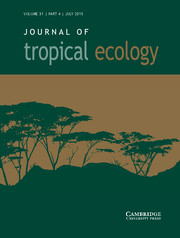No CrossRef data available.
Article contents
How do macrophyte cover and environmental variables influence the microcrustacean community across wet and dry seasons in a tropical marginal lake?
Published online by Cambridge University Press: 12 November 2025
Abstract
We analysed the composition, richness, diversity, abundance, and spatial and seasonal structure of zooplankton microcrustaceans (Cladocera and Copepoda) in a marginal lake of the Paranapanema River to assess how these organisms are affected by the expansion of macrophyte cover during the dry season. The community was monitored through quarterly collections, during the dry and rainy seasons, at nine sampling stations. We expected that (1) microcrustacean richness is higher during the rainy season due to the expansion of aquatic habitats and (2) the presence of macrophytes increases the richness and abundance of microcrustaceans by providing shelter and greater environmental stability. During the study, 31 microcrustacean taxa were recorded, displaying a clear seasonal distribution pattern. A clear seasonal distribution pattern was observed. Cladocera richness was highest during the dry season, which coincided with extensive macrophyte cover. In contrast, Copepoda abundance peaked during the rainy season, when macrophytes were absent. Macrophyte presence influenced abundance and diversity, with distinct taxonomic responses between the groups. The results suggest that seasonality and habitat heterogeneity are key factors in structuring the community in tropical lakes. These findings indicate that macrophytes play an important role in modulating the microcrustacean community, affecting structure, dynamics of abundance, and diversity. The interaction between seasonality and emergent aquatic vegetation is crucial for understanding the dynamics of marginal aquatic systems.
Information
- Type
- Research Article
- Information
- Copyright
- © The Author(s), 2025. Published by Cambridge University Press


